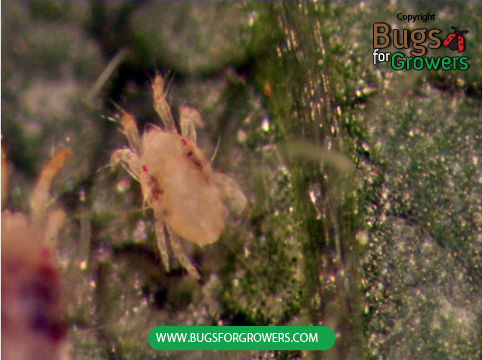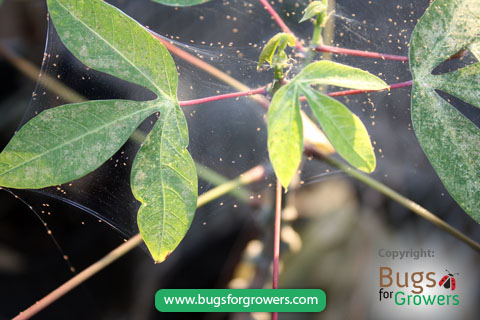Organic control of two spotted spider mites
Two spotted spider mites (Tetranychus urticae) are serious pests of many greenhouse plants and field crops but they can be organically controlled by using predatory mites called Amblyseius andersoni.
What are two spotted spider mites?
Adults of two spotted spider mites, Tetranychus urticae (Photo 1) are tiny, oval shaped mites with four pairs of legs. As name implies, they have two red spots on their body. In their life cycle there are two immature stages including larvae and nymphs exist. Both larvae and nymphs resemble to their parents but larvae possess three pairs of legs whereas nymphs have four pairs of legs.

Damage caused by two spotted spider mites
Two spotted spider mites suck cell sap (juice) from leaves and succulent twigs many field crops (cotton, peanut, potato and soybean), fruits (citrus and apples), vegetables (beans, cucumber, eggplant, pepper and tomato) and ornamental plants (azalea, camellia, hollies, ligustrum, roses and viburnum).
The major symptoms of feeding injuries caused by two spotted spider mites include mottled and speckled appearance of leaves (Photo 2), yellowing and desiccation of leaves, webbing on the leaves (Photo 2) and small branches with the fine strands and premature death of host plants.
Heavy infestation of two spotted spider mites also affects the photosynthesis that in turn reduces plant’s ability to make its own food. Severely infested plants can die prematurely.

What is predatory mite, Amblyseius andersoni?
Predatory mites, Amblyseius andersoni are currently used as beneficial mites to control two spotted spider mites that are pests of many field crops, fruits, vegetables and ornamentals.
Adults: Adults of Amblyseius andersoni are beige colored tiny and mites that are about 1.0 mm in size.
Eggs: Eggs of Amblyseius andersoni are oval shaped and colorless.
Larvae: Newly hatched mites are called as larvae that resemble to their parents but they have only three pairs of legs.
Nymphs: Next stage of larvae are called nymphs. Nymphs pass through two successive stages called protonymphs and deutonymphs. Both of these stages look like their parents. Like their parents, they also have four pairs of legs.
Life cycle: Overwintering predatory Amblyseius andersoni mites generally become active from January onward and remain active throughout the growing season. During growing season female mites lay eggs onto leaf hairs.
These eggs hatch into tiny larvae that develop into two successive nymphal stages known as protonymphs and deutonymphs.
Like their parents, both nymphal stages feed on the eggs, nymphs and adults of pest mites like two spotted spider mites. Amblyseius andersoni can survive, reproduce and develop at a wide range of temperature between 6-40°C (43-104°F).
Amblyseius andersoni mites are used for the organic control of two spotted spider mites because they voraciously feed on eggs, nymphs and adults of two spotted spider mites. These mites are also not harmful to plants, animals and pets.
How do Amblyseius andersoni kill two spotted spider mites?
- After application in the greenhouses or nurseries, Amblyseius andersoni mites immediately start looking for their prey such as two spotted spider mites.
- Once Amblyseius andersoni mites come across colony two spotted spider mites, they will start munching on the eggs, nymphs and adults of two spotted spider mites.
When and how Amblyseius andersoni mites should be released?
- Amblyseius andersoni mites are supplied as adults mixed in a container containing a mixture of bran and vermiculite.
- Hang containers to plants at every 5-12 feet in the garden or greenhouses.
- Because Amblyseius andersoni mites are very active, they will walkout themselves out of container and disseminate throughout the garden or greenhouse to seek their food, two spotted spider mites.
- As a preventive control measure Amblyseius andersoni mites should be released when there is a very low population of two spotted spider mites.
- As a curative measure Amblyseius andersoni mites should be released when there is a very high population of two spotted spider mites.
- Release Amblyseius andersoni mites when temperature and relative humidity is between 6- 40°C (43-104°F) and 40-60%, respectively.
How many Amblyseius andersoni mites should be released?
For effective control of two spotted spider mites, it is recommended to follow schedule below.
- Release 4-5 predatory mites/square feet (0.1 sq. meter) area bi-weekly, 2-3 times.
